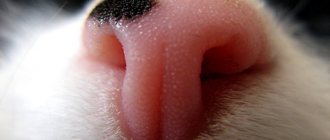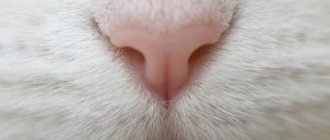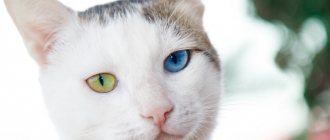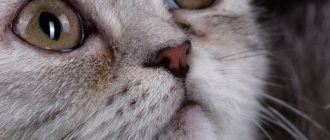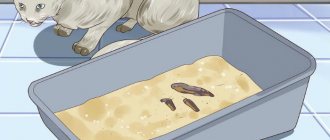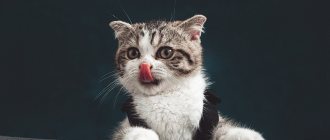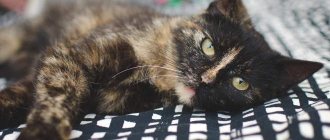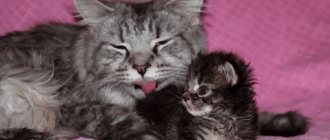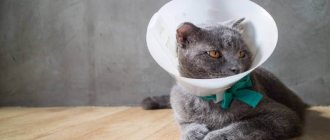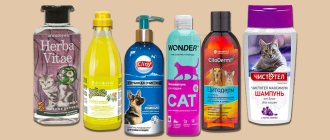A change in the color of visible mucous membranes is called anemia in veterinary and human medicine. During the development of the pathological process, the number of red blood cells and iron-containing protein decreases in the bloodstream. Anemia is not an independent disease - it is a kind of signal from the body, indicating the development of disorders in the functioning of certain systems.
Iron-containing protein, hemoglobin, is vital for the body, since thanks to it, oxygen is delivered to the tissue structures of the body. A cat suffering from advanced forms of anemia exhibits pronounced signs of hypoxia.
Normal color of mucous membranes in cats
Red blood cells are erythrocytes produced in the body in the bone marrow area. Subsequently, they penetrate into the systemic bloodstream, where they remain for about 120 days. As soon as red blood cells begin to age and become damaged, they are removed, and new blood cells begin to be produced from their remains. During the life of an animal's body, the number of red blood cells decreases due to a sharp loss of blood or as a result of their reduced production by the bone marrow.
A characteristic manifestation of anemia in animals is a change in the shade of visible mucous membranes. Under normal conditions, cats' gums are pink. With the development of anemia, the mucous membranes acquire a pale pink and sometimes white tint. The animal becomes lethargic and less resilient. If the cat owner has noted the whitishness of visible mucous membranes, lips and increased fatigue in the pet, it is necessary to contact a veterinary clinic for help and advice.
Cancer (neoplastic)
Various types of cancerous tumors occur in the nasal cavity. The most common type in cats is adenocarcinoma, but other types, including soft tissue sarcoma and lymphoma, also occur. Cancerous tumors can cause problems in one or both nostrils. Possible deformation of the muzzle. Usually, with neoplasms in an animal, changes can be seen on MRI or CT. Ultimately, to determine the type of tumor, it is necessary to do a biopsy, taking a piece of tissue for histological examination (evaluating a section of tissue under a microscope), or a puncture for cytological examination (evaluating cells in a smear). Treatment for cancer depends on its type. Endoscopic removal of the tumor, rhinotomy, radiation and chemotherapy are likely.
Causes of paleness in cats
One of the main formed elements of blood, red blood cells, are a depot for storing and transporting iron-containing protein. The average lifespan of red blood cells is about 3 months.
Hemoglobin, in turn, is represented by a complex protein compound that can bind to oxygen in the lung structures using an iron atom, subsequently delivering it to the cellular structures of the body. Without the participation of oxygen, not a single biochemical process occurs in the body of warm-blooded animals. In this regard, a sharp drop in red blood cells in the blood leads to disruptions in the functioning of all body systems.
The production of red blood cells, like other formed elements of blood, occurs in the structures of the bone marrow. There is a constant formation of elements and their subsequent destruction. The spleen is a hematopoietic organ responsible for the breakdown and disposal of spent red blood cells.
There are several factors that provoke the development of anemia in cats. Conventionally, the reasons are divided into several groups. Among them the main ones are:
- problems in blood formation processes;
- violation of factors contributing to the destruction of used red blood cells;
- problems in the balance of destruction and formation of new cellular structures of the bloodstream;
- malfunctions in the genetic apparatus.
Factors influencing the development of anemia indirectly affect the type of pathology. There are the following types of anemia in cats:
- posthemorrhagic type;
- caused by hemolytic processes;
- aplastic and hypoplastic;
- nutritional anemia.
The first type of anemia, posthemorrhagic, occurs in two forms - acute and chronic. The reason for the development of this type of pathology is external and internal hemorrhages. As bleeding develops, the number of red blood cells, and therefore hemoglobin, decreases. In the chronic form, there is a sluggish course of anemia associated with prolonged and regular loss of blood as a result of dysfunction of the liver and kidneys, bladder or other internal organs.
Posthemorrhagic anemia often develops against the background of severe infestation in the body. Parasites, in the course of their life activity, damage the integrity of the mucous membranes, causing minor but regular internal bleeding. The bone marrow does not have time to produce the required number of red blood cells, which results in anemia.
The second type of anemia is hemolytic, which develops as a result of the destruction of blood cells and with a further decrease in the amount of hemoglobin. Accompanied by hemolytic jaundice. It can be acquired or congenital. The acquired form of hemolytic anemia develops as a result of damage to red blood cells by toxins, blood parasitic organisms, viruses or poisons that penetrate the digestive system. Congenital anemia is caused by a genetic disorder, in which the formed elements of the blood cannot perform their functions normally. Taking medications such as Aspirin, which thins the blood, can provoke the development of hemolytic anemia.
An infectious disease, hemobartonellosis, can provoke hemolytic anemia. The source of infection is the bites of blood-sucking insects. Together with salivary secretions, parasites enter the bloodstream. Hemobartenella have the ability to attach to red blood cells, causing their destruction. The disease often occurs in a latent form and is called feline infectious anemia.
There is also a hypoplastic type of anemia associated with impaired formation of red blood cells due to problems in the functioning of the bone marrow or as a result of a lack of building components for the formation of red blood cells. Factors that provoke the development of hypoplastic anemia in cats are a lack of important microelements - iron, copper, cobalt, as well as protein components and B vitamins.
The most common form of anemia found in domestic cats is nutritional. The cause of disturbances in the body is a violation of the regime and rules of feeding the pet. Against the background of dietary disturbances, there is a decrease in the number of red blood cells in the bloodstream, accompanied by a decrease in the amount of iron-containing protein. The basic factor is an acute lack of iron in the diet, as well as problems with normal absorption with concomitant pathologies - inflammation of the digestive tract.
The clinical picture of anemia depends on the reasons that triggered the onset of the pathological process. There are also a number of common symptoms. The main ones are:
- change in the shade of visible mucous membranes - the mucous membranes of the mouth and eyelids acquire a bluish color (under normal conditions, the mucous membranes are bright pink);
- problems in normal cardiac activity - the heartbeat quickens, causing the development of shortness of breath;
- apathy and depression, rapid fatigue of the cat (the animal does not want to be active, preferring to lie down more);
- loss of appetite or complete refusal to feed;
- problems in the digestion process, growth retardation (kittens do not gain weight well).
In the case of the development of anemia against the background of large blood loss, the above symptoms are added - weakening of the pulse, decreased blood pressure, shallow breathing, and dilated pupils. It is possible to determine the presence of anemia in an animal at home, but without determining the underlying factors, it is not possible to prescribe adequate therapy.
Symptoms of dehydration
If a cat is in normal health and has free access to water, it maintains its own water balance. Signs of 6-7% dehydration become noticeable, the first of which is a pale nose.
Associated symptoms :
- discolored, dry gums;
- sticky saliva;
- sunken eyes;
- loss of skin elasticity.
Fluid loss of 10-12% has irreversible health consequences, and above 15% leads to the death of the cat.
When feeding dry food and little or no water in the bowl, the body may become dehydrated.
In other cases, dehydration occurs due to infection, poisoning, or traumatic damage to internal organs.
© shutterstock
The acute form of feline distemper (panleukopenia) is accompanied by severe thirst and vomiting, but the cat does not drink water. White plaque on a cat’s nose is one of the symptoms of this highly contagious infectious disease.
High temperature causes increased sweating and is accompanied by thirst. The cat has warm paws, ears, a white nose, and lies curled up in a ball.
Poisoning is accompanied by vomiting and diarrhea, which cannot always be noticed in time. Dehydration occurs quickly and requires urgent action.
Internal hematomas and bleeding due to falls from a height or fights cause severe weakness. Impaired blood supply to tissues leads to dehydration. Usually cats cannot drink and eat on their own due to severe weakness.
Diagnosis of possible diseases
Diagnostic measures include an integrated approach. Suspecting the development of anemia in a cat, the doctor takes into account the clinical manifestations and also prescribes a number of laboratory tests. An obligatory point of diagnosis is the collection of anamnesis.
A blood test is performed to determine the processes occurring in the bloodstream, as well as to determine the possible development of inflammation. If a bone marrow dysfunction is suspected, a bone marrow puncture is prescribed. Based on the data obtained, the veterinarian prescribes therapy.
What is atrophic rhinitis?
Atrophic rhinitis is a long-term inflammatory disease of the nasal mucosa, accompanied by its thinning. Main signs of the disease:
- increased dryness of the nasopharynx,
- viscous discharge of yellow or green color,
- the appearance of specific crusts,
- short-term bleeding.
Over time, most of the structure of the nose is affected: nerve endings, blood vessels, bone tissue. The disease affects adults, mainly women, and children, most often teenagers. However, sometimes atrophic rhinitis is detected in a child in early childhood (from 1 year).
An alternative name for chronic atrophic rhinitis is “dry” runny nose. This is explained by scanty secretions with severe breathing problems.
The disease is divided into two types:
- Primary.
It forms independently; the causes have not been identified to date. - Secondary.
Appears as a consequence of concomitant pathologies or surgical interventions.
Timely detection and subsequent treatment of atrophic rhinitis is extremely important because the disease quickly becomes chronic. If the mucous membranes do not perform protective and thermoregulatory functions, the functioning of most respiratory organs will be disrupted.
Techniques to improve pigmentation
The struggle for the ideal coat color is mainly faced by those who exhibit their young pets for the purpose of participating in breeding. Special shampoos and conditioners have been developed for each color to enhance the natural color of the coat. This type of washing is especially important for white cats, which should not have even a hint of yellowness.
For white and black individuals, special coloring powders are used before the exhibition. They can be dry or liquid. For especially problem areas in white cats (chin, tear ducts), gels with a whitening effect have been developed:
- All Systems;
- Super whitening gel.
Tinting is a harmless trick by breeders, giving an effect for no more than a day. To correct color for a long time, special nutritional supplements are used.
Suitable for red fur:
- complex Beaphar Algolit with seaweed (Beaphar Algolit Vitamin&mineral food supplement);
- GAC-carotene – granules from pure carrots containing carotene – provitamin A.
For darker colors, Seealgenmehl powder is recommended.
Prevention
The nose is one of those organs that undeservedly remains in the shadows when the owner examines the animal. Of course, cats are able to monitor the condition of their nose on their own and lick it when it gets dry. However, there are situations that trigger long-term inflammatory processes that the cat cannot influence. One of these situations is the already described penetration of a foreign small part into the pet’s nasal canals. Elementary carelessness of a cat can lead to painful symptoms that require serious treatment with antibiotics.
Even the owner can detect neoplasms such as polyps and quickly take appropriate measures
In this regard, a weekly nasal examination, even in the absence of cold symptoms, will be an excellent way to prevent respiratory diseases. Periodic examinations and palpating of your pet’s nose can protect him from advanced illnesses. You can check your pet's nose by touching it with the back of your hand.
All manipulations carried out with the cat must be done with clean hands.
Try to perform home diagnostics under sterile conditions. Wash your hands before palpating, even if you are sure they are clean. The possibility of infection due to negligence also exists on the part of the owner.
In addition to diagnostics, it is acceptable to clean your cat’s nose from time to time. If you are ready to deal with your pet's protest and calm him throughout the procedure, then the tips presented below will help you make the cleansing process easier.
How to clean a cat's nose
How does a cat's nose work?
A cat's nose is not very different in structure from the human nose. It includes two nasal canals, which are separated by cartilage. When a cat sucks in air, it enters the so-called “nasal chambers.” From the chambers, the air enters winding channels, in which it spends quite a long time, during which the cat recognizes the nature of the smell and reads its information. It is in these labyrinths of channels that the smell is cleared of other impurities that make it difficult to identify the scent of interest to the four-legged predator.
Cat's olfactory system
At the end of this maze, the molecules that enter the cat's nose interact with odor-sensitive cells responsible for recognition. These analytical cells are connected to the olfactory center of the cat's brain, which is responsible for diagnosing all aromas.
The nasal sinuses, in addition to their recognition function, play the role of a thermostat and filter. The air inhaled by the cat undergoes mandatory heat treatment (heated to a certain temperature) and is cleaned of the smallest particles of dust and bacteria.
Jacobson tube
All felines have synesthetic inclinations due to the fact that they can literally taste a smell. This opportunity is available to cats thanks to the Jacobson tube, an organ located above the upper palate. To use it, the cat needs to open its mouth and “retract” its lips, exposing the incisors
Cat using Jacobson's organ
Such an unusual “expression” of the muzzle sometimes makes a deep impression on the owners, since it sometimes resembles an angry grimace. In reality, such a grimace means that the pet has smelled either an unfamiliar smell and is busy analyzing it, or a smell that is of particular importance to him. Despite the fact that Jacobson's tube has been studied for a long time, there is debate about its exact role in the cat's body. The main points are:
- Jacobson's organ plays a predominantly social function. With its help, cats are able to smell pheromones and feel the proximity of an individual of the opposite sex. However, this body is designed not only to search for partners, but also to identify competitors and their “tags”;
- Jacobson's organ plays a subordinate role in relation to the sense of smell. It is actively involved during meals and helps the cat to perceive in detail the smell of food in the oral cavity;
The assumption, however, does not explain why the cat needs this additional information about food
- Jacobson's organ is the localization of the “sixth sense”. This hypothesis has an esoteric connotation and is based on the assumption that a cat’s hypersensitive sense of smell is capable of detecting the slightest changes in the chemical composition of the air. This skill allows cats to predict all natural disasters.
The question of the role of Jacobson's organ in the life of a cat remains open
Since there is no consensus on this issue, you can choose any item you like or come up with your own.
Nose
The lobe is the skin surrounding a cat's nostrils and is most often pale pink in color. All questions asked by owners regarding the condition of their pet’s nose, as a rule, do not relate to the organ as such, but only to its part – the lobe.
A cat’s nose is only part of an extensive olfactory system with which the pet’s life is inextricably linked.
Such naivety is very logical, since the nose is most accessible to a person and is capable of providing him with the most information about the cat’s condition. It is a kind of litmus test by which a person with basic knowledge of zoology can determine the well-being of a cat.
Normally, the nose should be:
- Slightly damp, but not wet;
- Cold;
- Rough.
By moistening the nose, cats can more clearly recognize surrounding odors.
The nose is directly involved in the pet's thermoregulation processes. Therefore, its condition may be a hint of possible pathological changes in the animal’s body. A warm earlobe often indicates an increase in body temperature and possible infections that the immune system has begun to fight.
Each cat's nose is individual and unique.
By the way! Upon closer examination of a cat's lobes, one can come to the conclusion that there is no repeating “pattern.” The rough noses of felines, indeed, are never repeated, just as human fingerprints are never repeated. This feature can be effectively used in animal identification.
Lobe color
It is difficult to make a specific diagnosis based on the color of the nose. The “color design” of the lobe directly depends on the breed and age. There are cats with noses of the following colors:
- Grey;
- Lilac;
- Lavender;
- Lilac;
- Brown;
- Black.
A black nose is quite natural for a black cat.
Cats are also affected by such specific phenomena as age spots on the nose. Animals can be born with ready-made springs, or acquire them as they grow older. For older individuals, an increase in the number of age spots is normal. Moreover, there are cats whose noses are decorated with freckles.
Persian Color Points have dark noses
By the way! Changes in nose color are the prerogative of color point cats. The peculiarity of their color is expressed in the presence of individual dark accents on the overall light background of the coat (dark muzzle, paws, tail or ears). Cats with a similar color are able to change color depending on the temperature. For example, the noses of such animals, like their fur, become darker in a cold room.
Hypopigmentation (lightening)
There are several genetic diseases in cats that result in a lack of pigment in the hair and skin. They are quite rare and cannot be treated:
- Persian cats have a bluish-smoky color with yellow eyes and have Chediak-Higashi syndrome. This disease causes not only discoloration of the coat, but also partial albinism of the eyes, photophobia and cataracts.
- Siamese cats (more often females) have vitiligo. In young animals, progressive patchy depigmentation of the nose, lips, eyelids, paw pads, and perianal area is observed. Although these cats cannot be used for breeding, vitiligo does not prevent pets from leading full lives.
Acquired lack of pigment can occur under the influence of any factors that destroy melanocytes:
- injuries;
- burns;
- frostbite;
- bacterial or fungal skin infection;
- use of certain medications (glucocorticoids).
Dangerous cancers - lymphoma, squamous cell carcinoma - can look similar to vitiligo.
What kind of nose should a kitten have?
The kitten's nose will be the same as that of an adult cat - slightly cold, wet, smooth.
But in kittens, the body temperature is slightly higher than adults, so the nose will be a couple of degrees warmer than usual. This is due to the fact that heat exchange in the channels is only developing. And the color of the nose changes with age, so expect that in the future, the color of the kitten's nose will be a shade darker than it is now.
Since kittens are playful and extremely active, their nose will often be dry. Don't worry, this is a normal condition.
Kittens are more susceptible to diseases.
How to examine a cat's nasal cavity
This is done exclusively by a veterinarian who uses special testing tools. The examination is carried out only under anesthesia so that the cat does not feel pain or discomfort.
Also, to measure temperature, the doctor inserts a thermometer into the anus - this is how the pet’s body temperature is measured.
The doctor will carry out procedures, identify important deviations and prescribe the correct treatment. Some procedures will have to be carried out exclusively with a doctor, some the veterinarian will show you, and you will treat the cat at home.
The help of a doctor will never hurt, because he will correctly diagnose and prescribe the right medications.
Non-critical anomalies
A healthy cat may also experience changes to its nose, but this does not mean that something terrible is happening unless it is accompanied by additional symptoms.
- Dream. During deep sleep, your pet's nose warms up and becomes dry. After the pet wakes up, the nose will remain dry for some time.
- Low humidity in the room or heat. Dry air also makes your pet's nose dry. A humidifier will help cope with this.
- Activity. After playing or running around, the spout heats up.
- Stress. The pet's excitement causes fear, and fear clogs some glands, causing the nose to become dry and hot.
- Age. In older individuals, the nose no longer performs its main function, so the nose dries out.
- Nutrition. Overeating or undereating is a consequence of problems in the body; the nose becomes hot.
- Hairballs. Some cats suffer with them for a long time because they cannot empty their stomachs of them.
All these symptoms go away on their own over time. Of course, if other symptoms also appear, you should think twice and take your pet to the doctor.
Monitor your pet's condition and daily routine.
